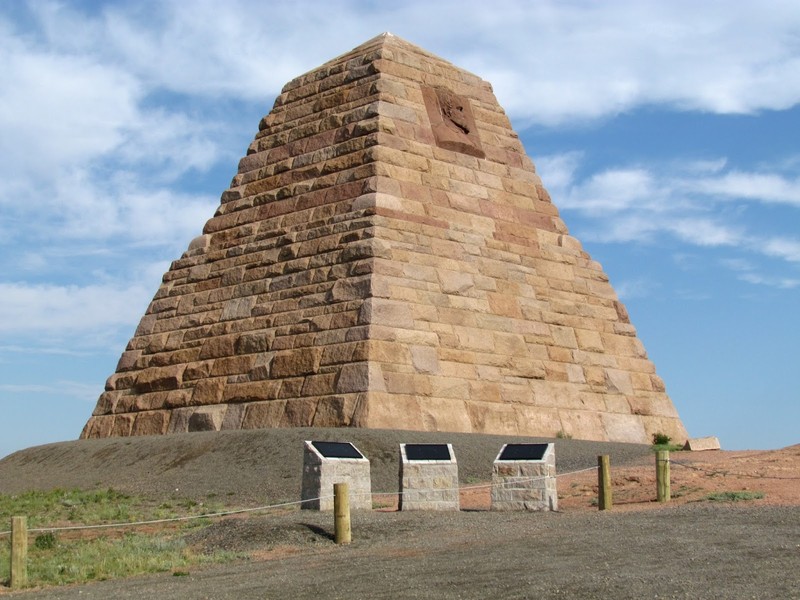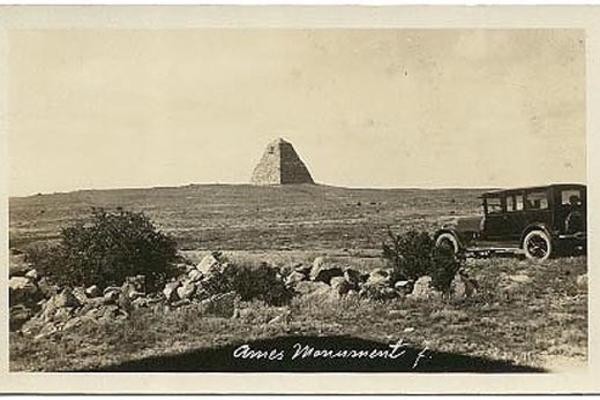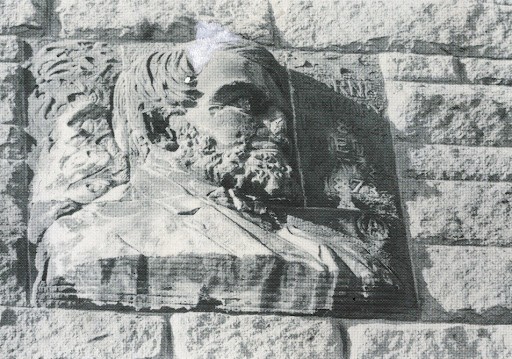Ames Monument
Introduction
Text-to-speech Audio
Images
The massive Ames Monument with historical markers in the foreground.

The monument from earlier times atop Sherman Summit.

A close-up of the damaged bas-relief sculpture of Oliver Ames Jr.

The since sealed passage that ran through the monument.

Oakes Ames who served in the U.S. House of Representatives from 1863 until 1873.

Oliver Ames Jr. serves as the President of the Union Pacific Railroad from 1866 until 1871.

Backstory and Context
Text-to-speech Audio
As the Civil War came to a bloody end in 1865, thoughts returned to construction of the delayed Transcontinental Railroad. President Lincoln tasked prominent member of the House Committee of Railroads, Oakes Ames from Massachusetts, to oversee construction of the eastern section. However, the Union Pacific Railroad, contracted to build said eastern section of the Transcontinental Railroad, saw its construction as an opportunity for graft and fraud. In 1864, executives of the Union Pacific Railroad, led by vice president of the company, Thomas Durant, created the fraudulent Credit Mobilier of America Construction Company. The Union Pacific then used the dummy Credit Mobilier Company to inflate construction costs of the Transcontinental Railroad. Congress paid over $94 million to Credit Mobilier, via the Union Pacific Railroad, while Credit Mobilier incurred operating costs of just over $50 million. Durant and the other Union Pacific executives shared the excess $44 million amongst themselves and their shareholders and most of this took place after Oliver Ames Jr., brother of Oakes, became the president of Union Pacific in 1866.
Union Pacific also used their ill-gotten gains to bribe sitting members of Congress by issuing them discounted shares of stock in return for favorable laws and regulations as well as continued funding for the Transcontinental Railroad. Thus, the congressmen now had a vested interest in ensuring the continued success of the Union Pacific Railroad and the Credit Mobilier Company in order to increase the value of their stock. Oakes Ames then further bridged the divide between Congress and the Union Pacific Railroad when he became a company executive in 1867, the same year the most egregious offenses occurred.
The scandal finally hit the press when a New York newspaper, The Sun, broke it in 1872 after receiving evidence from an Ames’ associate, Henry McComb. The House of Representatives then submitted nine names for investigation, to include the sitting Vice President, Schuyler Colfax. Oakes Ames was not among those initial names but was eventually investigated for selling stock in the Credit Mobilier Company to a fellow congressman at a price far below market value. He was then censured by the House in 1873. He resigned his seat and died soon after.
Despite the controversy and scandal, the Ames brothers were, without a doubt, quite instrumental in getting the eastern part of the Transcontinental Railroad built. As a result, the Union Pacific Railroad decided to memorialize their efforts with a monument dedicated to them beginning in 1875. After votes were taken, it was decided to locate the monument at the highest point the Transcontinental Railroad passed over near Sherman, Wyoming. Union Pacific then contracted with famed architect, Henry Hobson Richardson, to design their monument. As usual, Richardson chose rusticated granite for the structure and decided upon a large pyramid to honor the memory of the Ames brothers. The 60-foot tall, four-sided pyramid also has a base of 60 feet and was constructed by the Norcross Brothers of Massachusetts. Hobson and the Union Pacific also enlisted the services of sculptor, Augustus Saint-Gaudens, to fashion nine-feet tall, bas relief sculptures Oakes and Oliver Ames. They were chiseled in Massachusetts and then shipped west. However, the sculptures have since been damaged by vandals, the elements or both. When finally completed in 1882, the dedication ceremony was attended by President Rutherford B. Hayes.
The monument, town of Sherman and the railroad all existed together until 1918 when the Union Pacific moved the tracks about three miles south to take advantage of a less severe gradient. Sherman, named after the famous Union Civil War General, relied upon the railroad for its very existence. The people quickly left, creating one of numerous ghost towns that dotted the west. All that now remains is the town’s cemetery. Today, the interior passage within the monument has been sealed off and it is hoped that its designation as a National Historic Landmark in 2016 will bring with it much needed and deserved attention.
Sources
Allaback, Sarah, Ethan Carr and James O;Gorman. "National Historic Landmark Nomination Form: Ames Monument." United States Department of the Interior/National Park Service, November 21, 2014. Accessed May 8, 2020. https://home1.nps.gov/nhl/news/LC/fall2015/AmesMonument.pdf
Haderle, Carrie. "Ames Monument represents 'enormous feat.' Billings Gazette. January 8, 2011. Accessed May 8, 2020. https://billingsgazette.com/news/state-and-regional/wyoming/article_dd73ee7a-1b7f-11e0-81a1-001cc4c03286.html
Hasman, Gregory. "Ames Monument." Historic Wyoming. July 5, 2017. Accessed May 8, 2020. https://www.historicwyoming.org/profiles/amesmonument
"The Ames Monument by H.H. Richardson." Glessner House. May 23, 2014. Accessed May 8, 2020. http://glessnerhouse.blogspot.com/2014/05/the-ames-monument-by-h-h-richardson.html
